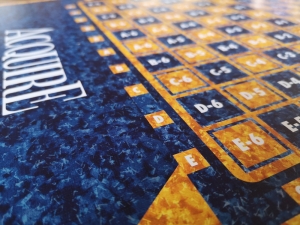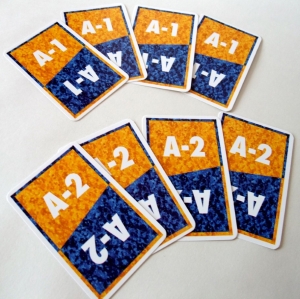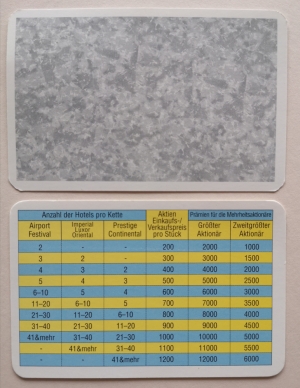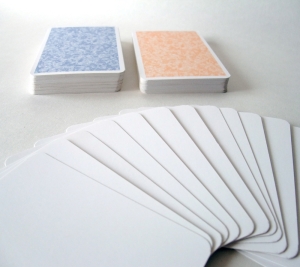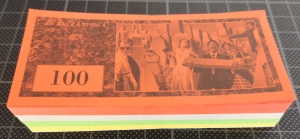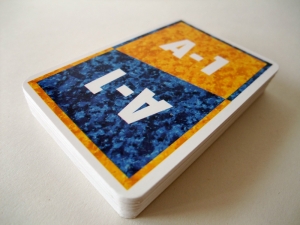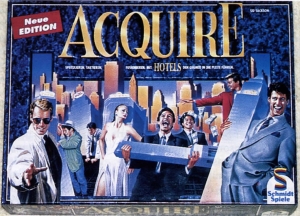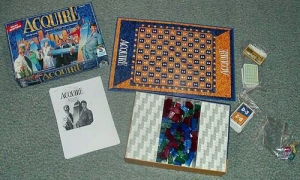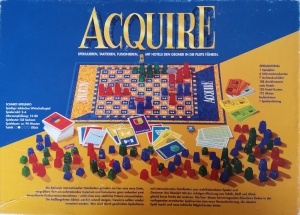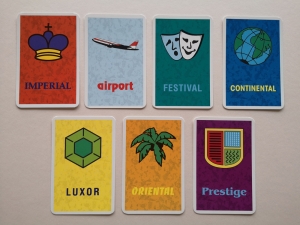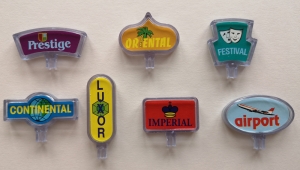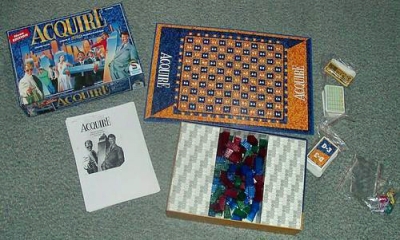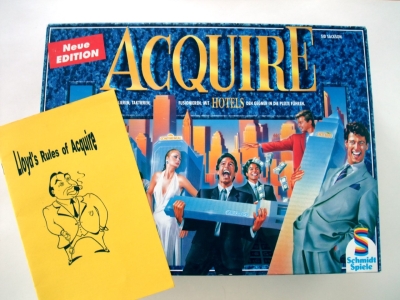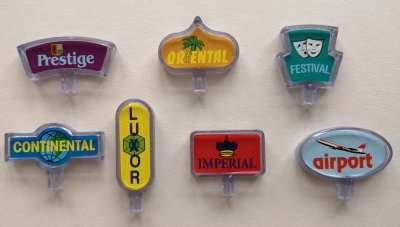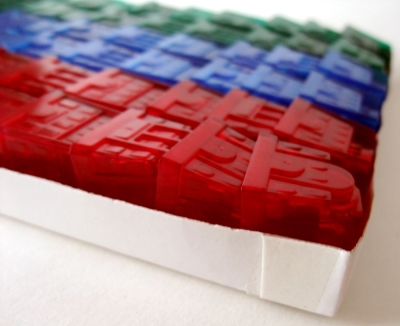The following excerpts are from conversations with Roland Siegers, the creator of the board idea for Acquire '97. These conversations transpired through email between August 31st and September 4th, 2012.
"For the toy fair in Nürnberg in 1997 just a few prototypes were made. The rules just exist as photocopy. Only the cards were produced, but the cards disappeared in the last days of surviving from Schmidt. Concerning the prototypes: I think 10, maybe 12, were made. I really don't know what happened to them. I suppose that the rare prototypes were destroyed. The only "complete" prototypes were "owned" by Knut Michael Wolf, maybe Bärbel Schmitz and me, as far as I know. Concerning the rules: I will send you today the rules, in German of course. At first I have to scan every page."
(A translation of these rules to English would be very much appreciated by anyone who is up for the task.)
"Concerning the dialog I have with Sid Sackson during this time: it was really funny. I saw him every year during New York toy fairs. He was pleased as I discuss with him over this variant and he agreed immediately to go ahead. This was the last time I saw him. It was only my idea and Sid says to me "Why did I not have this idea?" Anyhow, ACQUIRE is Sid Sackson's game and I just made a variant of the game." ~ Roland Siegers
The information and pictures in this section were provided by Knut-Michael Wolf, who is a game designer, game developer, and game expert from Germany. They are used with his permission:
"Schmidt-Spiele of Germany had planned the release of a new ACQUIRE for 1997. Unfortunately they went bankrupt, so only a few prototypes were made. (Schmidt-Spiele of today is a different company than that of yesterday.) ACQUIRE '97 was played on a different game-board. It was an idea by Belgian games-inventor, Roland Siegers, who at that time was responsible for the Schmidt game line. Sid Sackson had agreed to this variant. The spaces on the board were numbered from A-1 to E-6 only, but there were four copies of each space! The four A-1 spaces were placed in the center of the board, the E-6 spaces in the four corners." KMW
The following pictures, along with the two pictures of the board at the very top of this article, are copyrighted by Felix Schellenberg of Germany. Most of the description that I have been able to construct about this game is because of the contribution of Felix who actually owns a copy of the '97 ACQUIRE. He was able to purchase a rare copy in 2012 through an intermediary and subsequently sent me these pictures. They are used with his permission.
The picture on the front of the box looks the same as the 1993 Schmidt Spiel edition except for a red label in the top left corner that reads, "Neue Edition," which means "New Edition" in English. All the writing on the box is in German. The box is smaller than the 1993 box, which makes the picture more square.
The back of the box is much different than the 1993 edition. It has just a simple layout of the game instead of a picture of people actually playing the game. This allows a much closer view of the actual components of the game.
The layout of the board created four different quadrants on the same board and each quadrant has the same configuration of designations. Essentially this layout created four different boards on one game board. When a player draws a card they have multiple options, until the board begins to fill, to play that card instead of just one option. This idea by Roland Siegers instantly intensified the overall nature of the game. It created the possibilities of numerous games within one game. It increased the strategy of the game by taking away the certainty, of holding a card, that the player was the only holder of that card.
This game did not include the plastic grid to hold the buildings in place which was used in the 1993 edition. Without the plastic grid the buildings are susceptible to movement during game play and it would have been a huge detriment to the game. It is hard to imagine that Schmidt Spiele would have put these games into production without the grid. I would tend to believe that this was a "rushed" production in making these proto-types with limited design time and that the plastic grid would have been an added feature before mass production began.
Playing cards were used for building designation, but there were four cards with the same square designation. These cards were designed differently than the 1993 edition as they were designed to match the coloring on the new board. The backs of the cards were printed with a yellow pattern. The player had to decide in which quadrant they wanted to place their building.
The main strategy of the game of ACQUIRE has always been to shrewdly purchase stocks in the appropriate companies. The "appropriate companies" hinges on the players "luck of the draw" when choosing designation cards. This new board concept now reduces the luck of the draw and replaces it with an increase in strategy concerning building placement. This means that the game has created a higher confidence in the strategy of investing because of the addition of the strategy of building or merging.
The board has 120 squares (10 rows of 12 squares). Each quadrant has 30 squares. The quadrants keep all players involved in the game by decreasing their odds of having a hand of cards that are all away from the action of the game. This increases the odds of building placement, company growth, and mergers to 1 in 30 instead of 1 in 108 as in the normal game of ACQUIRE. It also changes every player's ability to make a difference in the game from less than 1% to over a 30% chance every move. That is true with every move by every player in the game. With mergers becoming more frequent, cash flow is increased during the game. This concept would also reduce the potential for players to run out of money during the course of the game.
This edition was very inexpensive in its design for Schmidt Spiele. It used the same stock certificates, buildings, company markers, money, and information cards that were used in the 1993 edition.
The backs of the stock certificates were printed with a blue design, while the backs of the information cards were printed with a charcoal design. (The picture on the left illustrates numerous "blank" cards. Felix surmised that since these games were proto-types, maybe they just threw the extra cards they had in the box.) The only new design was for the board, box, and designation cards. Yet that was all they needed to change to create a future for the game of ACQUIRE that would have been much brighter than where the game has currently evolved.
It is a prominent saying that "you don't miss what you don't know." After researching this game, I for one am truly missing what I don't know, and I hope someday I will know it.
In January of 2020 I sent an e-mail to Knut-Michael Wolf (KMW) to inquire if he still owned his copy of '97 ACQUIRE. I received an e-mail back from Berthold Heß with a very interesting story concerning that copy. The transcripts used in the following dialogue are from an article that appeared in Spielbox Magazine 2-1999 and was written by Berthold Heß. They are used with his permission. We have provided a link to this article entitled, "Very, Very Rare: ACQUIRE!"
Berthold Heß was fortunate enough to play '97 ACQUIRE in November of 1996. Knut-Michael Wolf (KMW) came over to play a "new" game with him. When KMW placed it on the table, Hess thought he was trying to fool him. This was ACQUIRE. But upon further examination he noticed the board.
"This simple sounding change changes the game enormously. In the well known ACQUIRE versions it is very important to have certain cards in your hand in order to control a possible takeover. For example, if two chains can only merge in the field B-3, this gives the player with the B-3 card absolute control over it. But in the new version there are four B-3 cards! It's still important to have the right card, but you can't control what happens endlessly, because at some point one of the other players will get one of the other cards in his hand. This new version convinced us all around. It brought more dynamics and excitement to this already first-class game. New hotel chains are created much faster, and there are also more mergers. The game is less predictable and more random."
Heß was very fortunate to have that moment in time. The game was later shown at the '97 Nuremburg game show, but "the game was only shown "in the closet" on request." Schmidt Spiele was planning to put the game out in the Fall of 1997, but the company went into bankruptcy in the Spring of 1997.
This sent Berthold Heß on a mission. This was the best variant of ACQUIRE he had played and he desperately wanted a copy of the game. Everywhere he turned he came up empty. Finally Roland Siegers was able to give him some more of the story:
"Despite TV advertising, sales of ACQUIRE between 1993 and 1995 had not reached the target figures. Should the game be removed from the program or should a new attempt be started? Not least because there was still a large stock of the expensive game pieces, Schmidt gave the game another chance. Siegers had always been annoyed that the owner of a card could block a field. So he tinkered until he had developed the present version. The agreement of Sackson as author and Avalon Hill as licensor was obtained and hand samples were made. The game was never properly produced. There should have been a larger number of decks, the pieces were from the previous version."
Siegers told Heß about the limited number of production units and the even smaller number of complete proto-types. Siegers also spoke about the uncertainty of how many or where these complete proto-types might be.
Heß had resided himself to the reality that he would probably never be able to own a copy of '97 ACQUIRE. Then in the summer of 1998 the mailman delivered him a special package on his birthday.
"In it I found the game I had been looking for so long. KMW had actually found one for me! If this is not friendship?!"
Heß surmised in his article:
"Should there really be a new edition again, the publisher should think very seriously about taking the version of Sackson and Siegers, because in my opinion this is the best."
The future of ACQUIRE was almost hatched in this plan by Roland Siegers to create '97 ACQUIRE or, you could say, "Quadrant ACQUIRE," and would have been well received by a fan base that is yearning for more from the game. This edition probably would have ultimately altered what Hasbro has subsequently done with the game by creating an overwhelming demand for this idea. Due to Mr. Siegers' fantastic ingenuity, ACQUIRE fans can always hope for the "Holy Grail of ACQUIRE." It would be impossible to imagine what a copy of this edition would bring on the open market.
© 2020 Lloyd T. Solon
Spielbox Magazine Article about the 1997 Game of ACQUIRE
German Rules for the 1997 Game of ACQUIRE
← Go back to International Versions of ACQUIRE


